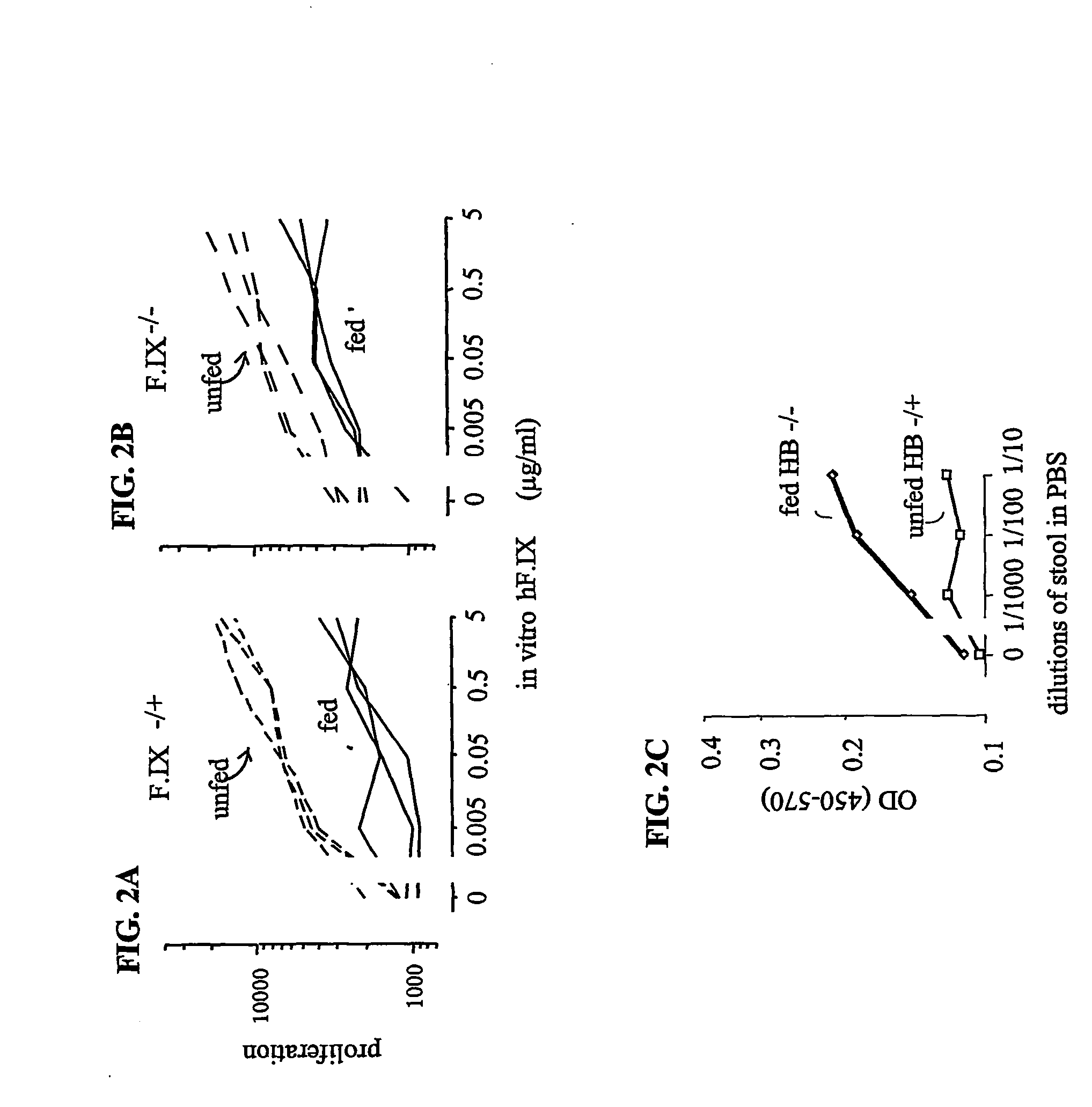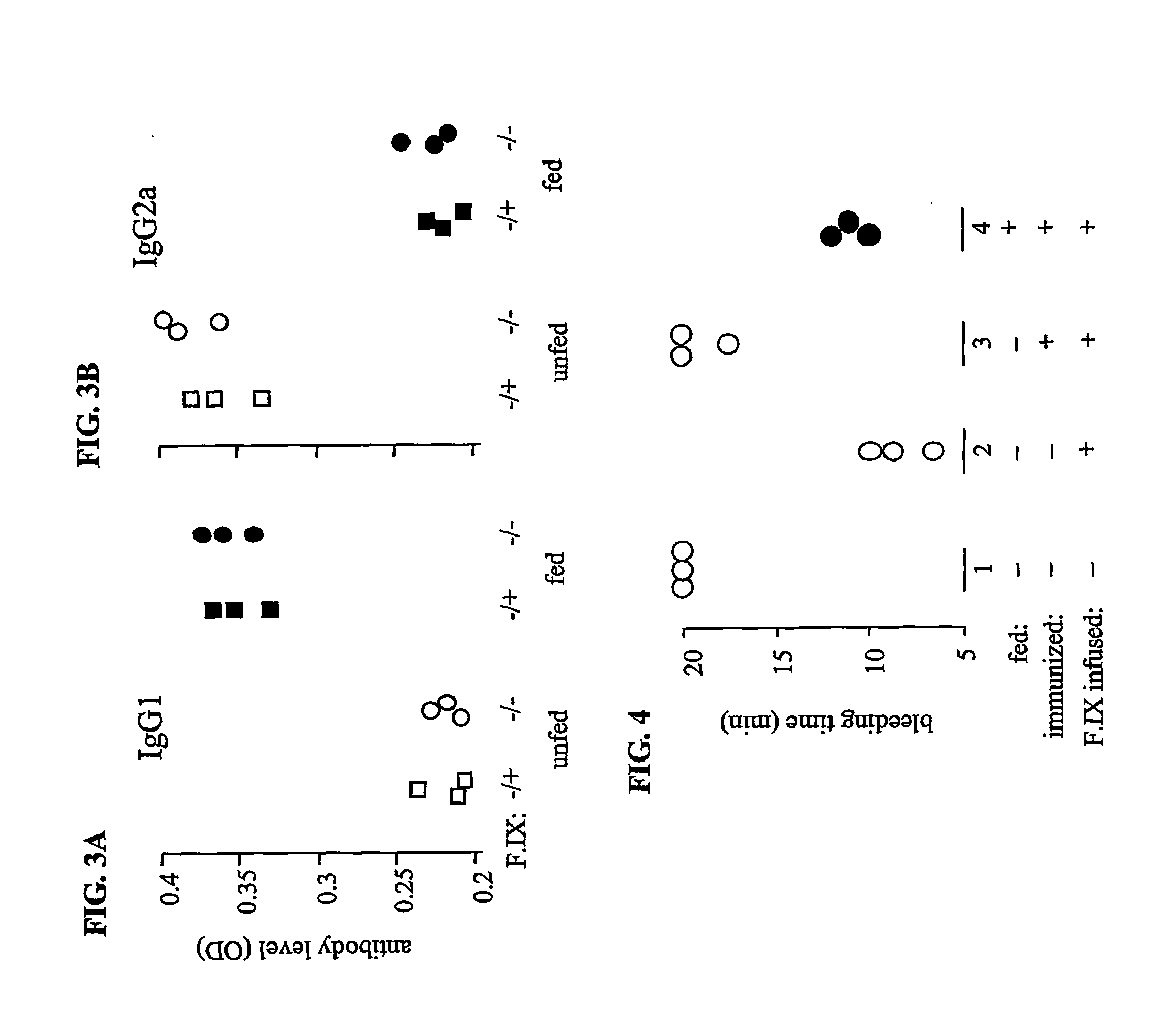Oral treatment of hemophilia
- Summary
- Abstract
- Description
- Claims
- Application Information
AI Technical Summary
Benefits of technology
Problems solved by technology
Method used
Image
Examples
example 1
Ovalbumin Oral Tolerance
[0109] This example describes the methods used to induce oral tolerance in mice to ovalbumin (OVA) by first orally administering OVA prior to immunization with OVA. Similar methods can be used to test any antigen of interest, such as F.VIII, F.IX, protein C, or insulin, in any animal / subject of interest.
[0110] Normal B10 mice were fed OVA by adding the protein to their drinking water for eight days at concentrations of 0.02, 0.2 or 2 mg / ml. The mice drank an average of 5.2 ml / mouse / day. Therefore, the doses were 0.1, 1.0 and 10 mg / mouse / day of OVA. Control mice only drank water. Two days after the last feeding, all mice were immunized with 50 .mu.g OVA in complete Freund's adjuvant (CFA) (Sigma, St. Louis, Mo.) in the left footpad. Seven days later, footpad swelling was determined by measuring the thickness of the footpad. Measurement of the right (un-injected) footpad served as an untreated control. The footpad swelling responses were compared between inject...
example 2
Factor IX Oral Tolerance
[0113] This example describes experiments in which mice developed oral tolerance to F.IX by orally administering F.IX prior to immunization with F.IX, using the methods described in EXAMPLE 1.
[0114] Briefly, normal B10.A mice (F.IX- / +) or hemophilia B mice (F.IX- / -) were fed transgenic human F.IX (hF.IX) in pig milk (see EXAMPLE 5) or control pig milk (no hF.IX) every other day for three weeks. Individual mice drank about 4 ml (10 .mu.g hF.IX / day / mouse) of the milk at each time. Two days after the last feeding, all mice were immunized with 50 .mu.g human F.IX emulsified in CFA at the base of the tail. Eight days later, the amount of T cell proliferation was determined by culturing T-cells from the lymph nodes with graded concentrations of human F.IX (purified from the transgenic pig milk) for four days using the methods described in EXAMPLE 1. As shown in FIGS. 2A and 2B, feeding mice human F.IX had a similar effect to the result observed in EXAMPLE 1 for OVA...
example 3
Antibodies Produced by Orally Tolerized Hemophilia B Mice Do Not Result in Clinical Resistance to Infused F.IX
[0116] To measure IgG1 and IgG2a antibodies specific for hF.IX, plates were coated with hF.IX (10 .mu.g / ml in PBS) then blocked with BSA overnight. After five washes, serum samples from the normal and hemophilia B mice fed as described in EXAMPLE 2 were added and incubated for two hours. The plates were then washed and subsequently incubated with HRP-conjugated goat-anti-mouse IgG1 and IgG2a for two hours, followed by TMP for color development, and plates subsequently read on an ELISA plate reader. As shown in FIGS. 3A and 3B, whereas unfed control mice made strong IgG2a antibodies, mice fed with hF.IX made no detectable IgG2a, but did produce IgG1.
[0117] Therefore, in normal mice, oral administration of human F.IX did not completely inhibit the production of small amounts of antibodies after immunization in CFA, as detected in ELISA assays, although it caused a shift from I...
PUM
| Property | Measurement | Unit |
|---|---|---|
| Weight | aaaaa | aaaaa |
| Mass | aaaaa | aaaaa |
| Mass | aaaaa | aaaaa |
Abstract
Description
Claims
Application Information
 Login to View More
Login to View More - R&D Engineer
- R&D Manager
- IP Professional
- Industry Leading Data Capabilities
- Powerful AI technology
- Patent DNA Extraction
Browse by: Latest US Patents, China's latest patents, Technical Efficacy Thesaurus, Application Domain, Technology Topic, Popular Technical Reports.
© 2024 PatSnap. All rights reserved.Legal|Privacy policy|Modern Slavery Act Transparency Statement|Sitemap|About US| Contact US: help@patsnap.com










